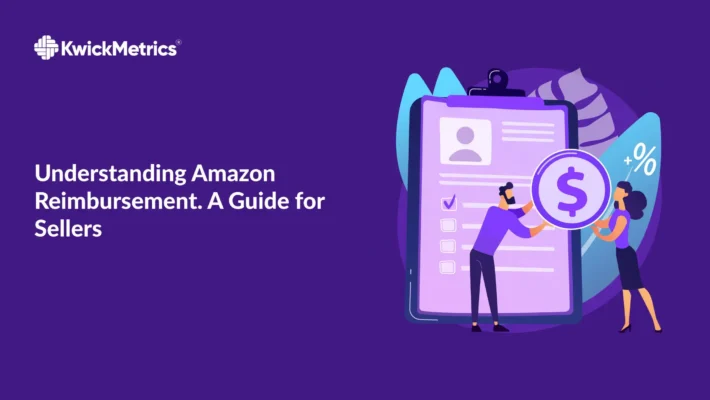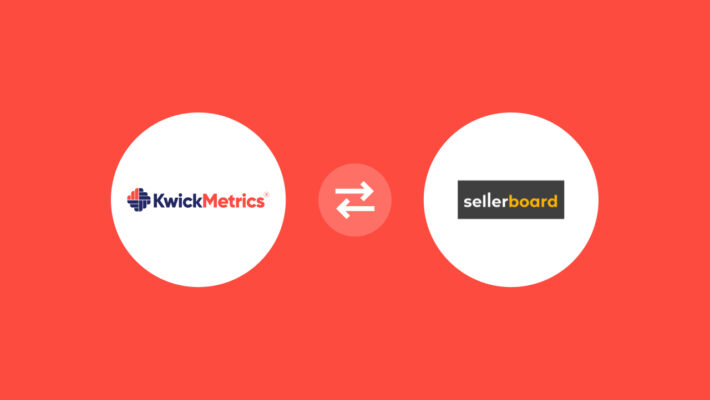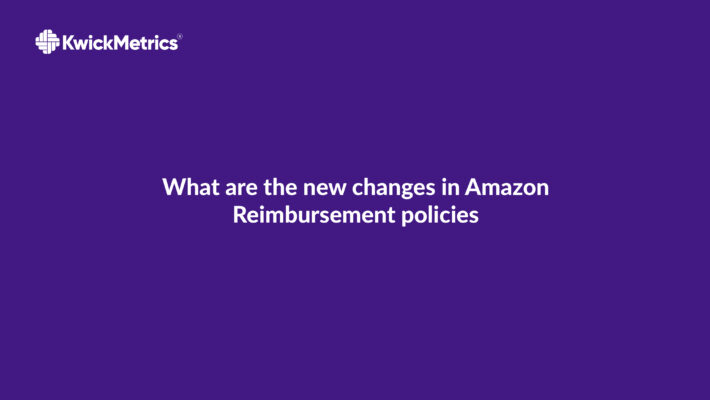Reclaiming Lost Inventory Costs through Amazon Reimbursement Process

Table of Contents
- Amazon FBA reimbursement policy for Lost Inventories
- Check How Much Money You Deserve to Get Back!
- Potential Amazon Reimbursement Situations for Missing Inventory
- Try our Amazon Analytics Tool with a 14-day Free Trial!
- Strategies for Minimizing Loss in Amazon FBA Inventory
- KwickMetrics: Your Partner in Amazon Reimbursement Success
- KwickMetrics Amazon Reimbursement Service - Your Key to Maximise Profits!
- Recovering Investments: Mastering Lost FBA Inventory Costs
- FAQs in Relation to Amazon Reimbursement
- Conclusion
Embark on a journey to reclaim lost profits and streamline your Amazon FBA experience with our comprehensive guide on navigating the Amazon reimbursement process. From identifying lost inventory to filing reimbursement claims, empower yourself with the knowledge and strategies needed to safeguard your investments and optimize profitability in the competitive e-commerce landscape.
Amazon FBA reimbursement policy for Lost Inventories
Amazon defines lost inventory as items that are rendered unavailable for purchase due to various factors, including damage, misplacement, or theft. Understanding the policies surrounding reimbursement for lost inventory is crucial for FBA sellers.
Identifying Lost Inventory
The first step is identifying that inventory has indeed been lost. This involves closely monitoring your Inventory Event Detail report. The aim here is to compare the expected quantity with what actually arrived at the fulfillment center.
If there’s any discrepancy, it might indicate missing items – these are potential candidates for making claims on amazon reimbursements. You’ll need to get familiar with Seller Central Account and understand how FBA transactions work within this platform because all of these steps take place right there.
Once identified, you start by filing a claim under ‘Fulfillment’ > ‘Customer Concessions’ > ‘Replacements’. Be sure to include specific details about order quantity and provide clear evidence pointing towards loss or damage during transit or handling at one of Amazon’s fulfillment centers.
Timeframe for Reimbursement Requests
Monitoring inventory regularly is a key practice for FBA sellers. In case of a discrepancy or loss, sellers have a specific timeframe within which they can submit reimbursement requests. Amazon typically allows FBA reimbursement requests within 18 months from the time the inventory is declared as lost. Sellers should initiate the reimbursement process promptly to ensure timely resolution.
Check How Much Money You Deserve to Get Back!
Proof of Loss Documentation
To initiate Amazon FBA reimbursement request, sellers may be required to provide comprehensive documentation as proof of loss. This documentation includes essential details such as shipment IDs, packing lists, and evidence highlighting the discrepancies between the quantities shipped and those received by Amazon. Accurate and detailed documentation is critical for the success of the reimbursement claim.
Fulfilling these criteria and adhering to the outlined policies ensures that FBA sellers can navigate the reimbursement process effectively and recover the value of lost inventory. Regular monitoring, timely submission of Amazon seller reimbursement requests, and meticulous record-keeping contribute to a seamless experience within the Amazon FBA ecosystem. The timeframe for raising a claim has been reduced from 18 months to 60 days. This change will take effect on October 23, 2024 for amazon.com US marketplace alone. It is 18 months for all other amazon marketplaces.
Key Takeaway:
Amazon FBA is a lifesaver for sellers as it handles storage, shipping, and returns. However, when inventory goes missing or gets damaged during the process, understanding Amazon's reimbursement policy becomes crucial. This policy covers losses that occur in transit or at their warehouses but it needs you to kickstart the claim yourself. To stay ahead of the game, make sure you review your FBA reports regularly and deal with any differences right away.
Potential Amazon Reimbursement Situations for Missing Inventory
Inbound Shipment Loss
One of the common scenarios for lost inventory reimbursement involves items lost during the inbound shipping process. Sellers can file reimbursement requests for these losses, underscoring the significance of maintaining thorough shipment documentation. This emphasizes the need for sellers to document each inbound shipment comprehensively, providing a basis for reimbursement claims in case of losses during transit.
Warehouse Misplacement
Warehouse misplacement is another scenario where FBA sellers can seek reimbursement. When items are misplaced within Amazon’s extensive network of warehouses, sellers can initiate reimbursement claims by presenting evidence of the lost items. This could include discrepancies between the recorded location of inventory and its actual placement within the warehouse. Sellers must be proactive in monitoring and documenting such instances to support their Amazon reimbursement claims effectively.
Theft or Damages
In unfortunate incidents of theft or damages to inventory, sellers can claim Amazon reimbursements by promptly reporting the incident to Amazon and providing the necessary documentation. This documentation may include reports of theft, photographic evidence of damages, or any other relevant information that supports the claim. This scenario underscores the importance of vigilance and quick response in the face of unexpected events that can result in inventory losses.
FBA Customer Returns
Monitoring return discrepancies is a critical aspect of FBA operations. In cases where items received from customer returns go missing, sellers should file for FBA inventory reimbursement. This necessitates a close examination of the return process, ensuring that items are correctly processed, restocked, or reported as damaged. Sellers should be proactive in identifying and addressing discrepancies to safeguard their inventory and financial interests.
Navigating these scenarios requires a combination of proactive monitoring, detailed documentation, and swift communication with Amazon. By understanding the intricacies of each scenario and adhering to Amazon’s policies, FBA sellers can optimize the likelihood of successful amazon reimbursement claims in the event of lost inventory.
Try our Amazon Analytics Tool with a 14-day Free Trial!
Strategies for Minimizing Loss in Amazon FBA Inventory
Regular Inventory Monitoring
Incorporating regular inventory monitoring practices is fundamental to identifying discrepancies early on and preventing potential losses. Sellers should conduct routine checks on their inventory levels, comparing them against recorded data. Early detection of discrepancies allows for swift corrective action, whether it involves investigating possible misplacements or addressing inaccuracies in inventory records. This proactive approach is instrumental in minimizing the risk of lost inventory.
Effective Labelling and Packaging
Ensuring correct labelling and secure packaging is a proactive measure that significantly reduces the risk of inventory damage or misplacement. Properly labelled items facilitate accurate tracking and handling, minimizing the chances of items being lost within Amazon’s vast fulfilment network. Secure packaging protects items during transit and warehousing, further contributing to the prevention of potential losses. This practice emphasizes the importance of robust packaging standards to safeguard inventory integrity.
Work with Reputable Carriers
The choice of carriers for shipping inventory to Amazon directly impacts the likelihood of inventory loss during transportation. Opting for reputable carriers with a track record of reliable service reduces the risk of mishandling or loss in transit. Sellers should prioritize carriers known for their commitment to secure and timely delivery, thus minimizing the potential for inventory-related issues. This best practice contributes to the overall risk mitigation strategy when it comes to avoiding lost inventory.
KwickMetrics: Your Partner in Amazon Reimbursement Success
-
- KwickMetrics Dashboard: A comprehensive KwickMetrics dashboard designed for efficient FBA auditing, offering an intuitive and visually rich interface for quick insights into discrepancies.
-
- Reimbursement tool: KwickMetrics emphasizes tools such as the Amazon Reimbursement management, providing a streamlined approach to identify and claim reimbursements efficiently.
-
- Category tree and User-Friendly Interface: Organizes products effectively, ensuring ease of navigation and simplifying the overall reimbursement process. Benefit from an intuitive category tree, enhancing efficiency and simplifying the entire reimbursement process for a user-friendly journey.
-
- Customization and Combined Services: KwickMetrics delivers unparalleled FBA auditing and reimbursement services, emphasizing customization. Our all-in-one platform ensures a seamless experience. Benefit from custom reports and tailored solutions, designed to meet individual business needs. Contact us for details on how our personalized services can elevate your success in the e-commerce landscape.
KwickMetrics Amazon Reimbursement Service - Your Key to Maximise Profits!
Time-Saving Efficiency
-
- Efficient Reimbursement Process: KwickMetrics streamlines the identification and claiming of reimbursements, allowing sellers to save time and effort.
- Focused Business Growth: Sellers can concentrate on business growth, knowing that KwickMetrics efficiently handles the intricacies of the reimbursement process.
Maximizing Returns
-
- Advanced Technology: KwickMetrics utilizes advanced technology and algorithms to identify potential reimbursement opportunities that might otherwise go unnoticed.
- Reinvestment Confidence: Sellers can maximize returns and reinvest in their business with confidence, thanks to KwickMetrics’ optimized approach to reimbursement.
Key Takeaway:
But worry not. As an Amazon FBA seller, you can tackle lost inventory effectively. Just keep a close watch on your Inventory Event Detail report and get the hang of how Seller Central Account operates. This will help you spot any missing items that need reimbursement claims. To file these, go to 'Fulfillment' > 'Customer Concessions' > 'Replacements'. Make sure to give specific details for clear understanding.
Recovering Investments: Mastering Lost FBA Inventory Costs
Critical Factors to Acknowledge Before Initiating Reimbursement
- Reimbursement Cap: Applicable for claims under $5,000.
- Calculating Reimbursement: Based on the product’s average selling price and current list price, minus Amazon fulfilment and referral fees.
- Essential Documentation: Ensure you have the necessary paperwork, including the lost product’s invoice from your supplier.
Unveiling the Steps to Recovery
- Navigate to ‘Manage FBA Shipments’ under the ‘Inventory’ drop-down menu.
- Within the shipment of interest, click on ‘Track Shipment.’
- Head to the ‘Content’ tab and locate ‘Action Required‘ in the dropdown menu on the right.
- Opt for ‘Research Missing Units.’
- Upload the Invoice for the lost product from your supplier in ‘Step 2. Upload documents.’
- Click ‘Upload file‘ after selecting the document in the required format (PDF or jpg).
- Skip ‘Step 3. Provide additional information.’ Instead, click ‘Preview your request.’
- Confirm your selections in the popup by clicking ‘Submit.‘ Your part is complete!
- Upon approval, Amazon will notify you via email about the reimbursement. Cross-verify in the ‘Reimbursements‘ section under the ‘Payments‘ tab.
- Bonus Tip: Ensure the date on the invoice precedes the shipment date, and the buyer’s name on the invoice aligns with your Legal entity on your Amazon seller account.
Insider Tips for a Seamless Process
- Processing Period: Amazon’s processing time for reimbursement requests may extend up to 60 days.
- Verification Stage: After the shipment status is ‘closed,’ meticulously compare the ‘Units received‘ quantity with your shipment quantity.
Key Takeaway:
Steering your Amazon FBA business to success requires a keen eye on inventory management. Regular monitoring with tools like KwickMetrics can help spot discrepancies early, while effective labeling and packaging protect your investments during transit. Additionally, leveraging KwickMetrics' reimbursement tools can streamline tracking and claiming for lost or damaged stock, helping you make the most of every opportunity.
FAQs in Relation to Amazon Reimbursement
How do I get reimbursed from Amazon?
To get a reimbursement from Amazon, you need to file a claim detailing your lost or damaged inventory and provide the necessary documentation.
What is an Amazon reimbursement?
An Amazon reimbursement is when sellers are refunded for their FBA losses due to misplaced, damaged, or incorrectly returned items in the warehouse.
How do I check my reimbursement report on Amazon?
You can check your reimbursement report by logging into Seller Central, navigating to Reports > Fulfillment > Reimbursements under Inventory Adjustments.
Does Amazon reimburse for customer damaged?
Yes. If a customer damages an item during return shipping, then according to FBA policies, sellers may be eligible for compensation.
Conclusion
Amazon reimbursement is not just a term, it’s your ticket to reclaiming lost profits. Understanding Amazon FBA and its policies is key.
You’ve learned how to identify lost inventory and make the necessary claims. It may appear intimidating initially, yet with thorough records available, you can ace this procedure like a specialist.
We delved into common scenarios where reimbursements come into play – inbound shipment losses or warehouse mishaps. Knowledge of these situations prepares you for any bumps on the road ahead.
Finally, prevention beats cure every time. Regular monitoring of your inventory will minimize potential loss and keep that hard-earned cash where it belongs – in your pocket!


